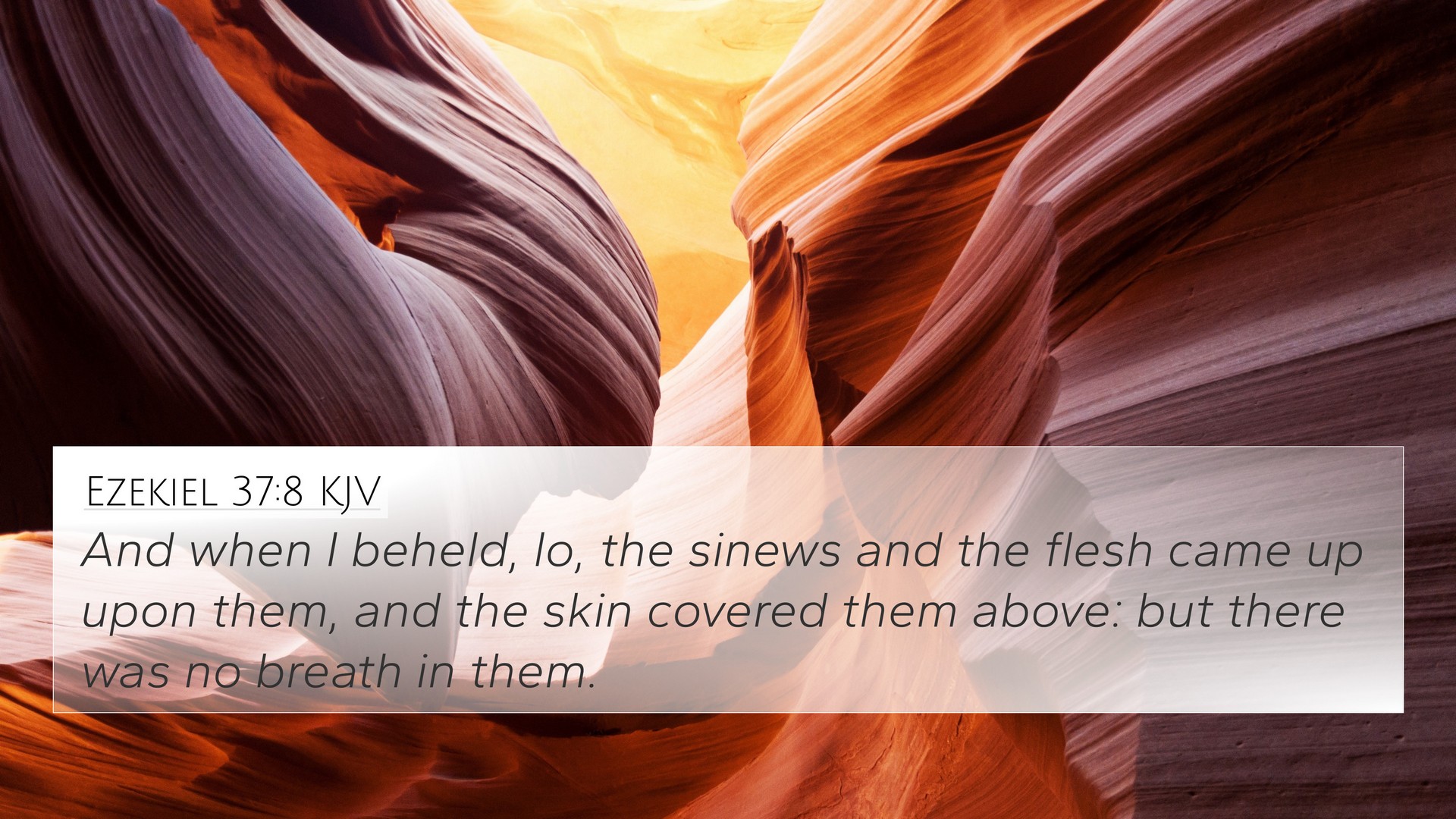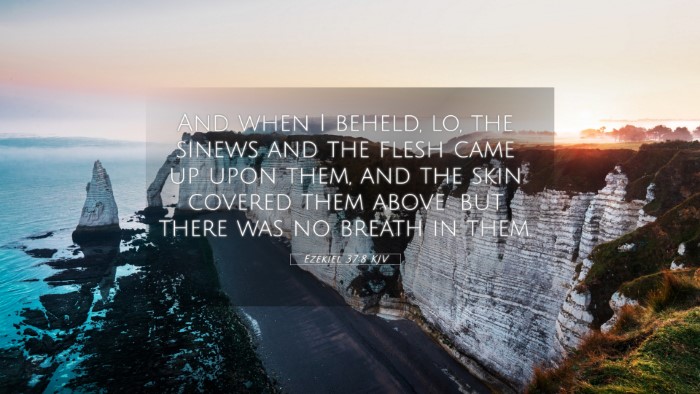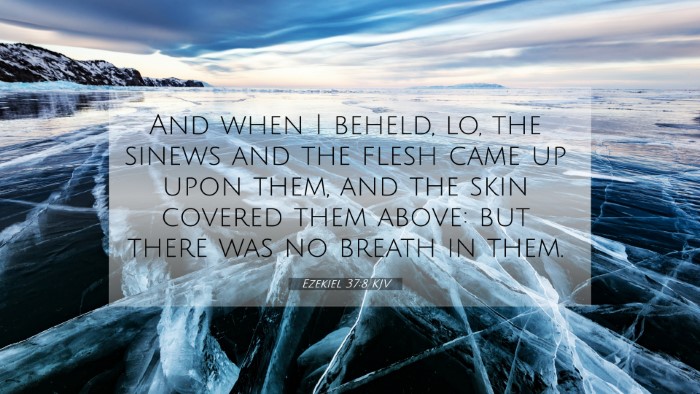Ezekiel 37:8 - Meaning and Interpretation
Ezekiel 37:8 is a pivotal verse in the prophetic vision known as the Valley of Dry Bones. This passage explores themes of restoration, hope, and the profound work of God in reviving the nation of Israel from despair. To better understand this verse, we can reference public domain commentaries such as those by Matthew Henry, Albert Barnes, and Adam Clarke.
Verse Analysis
Ezekiel 37:8 (KJV): "And when I beheld, lo, the sinews, and the flesh came up upon them, and the skin covered them above: but there was no breath in them."
This verse depicts the miraculous event where Ezekiel sees the skeletal remains of the house of Israel receiving flesh and sinews, a symbol of restoration. However, despite this transformation, the absence of breath signifies that while physical restoration is taking place, true life, represented by the Spirit of God, is yet to be realized.
Commentary Insights
The insights from the commentaries help us grasp the deeper meanings behind the imagery used in this verse.
-
Matthew Henry:
Henry emphasizes the symbolism of the flesh and sinews representing Israel's physical restoration, but he is quick to note that genuine revival requires the Spirit of God. The resurrection of Israel is incomplete without the divine breath.
-
Albert Barnes:
Barnes points towards the theological implications of this verse, suggesting that it highlights not just a national revival but also the importance of spiritual life. The progression from bones to bodies signifies God's promise to restore His people, but again it stresses that without the spirit, there is no true life.
-
Adam Clarke:
Clarke discusses the transformative power of God, linking the sinews and flesh as the works of His hands. He underscores that this physical restoration is a precursor to a much greater spiritual awakening that is to come for Israel.
Thematic Connections
The themes presented in Ezekiel 37:8 can be further linked to several other Bible verses that resonate with similar ideas of restoration and renewal:
- Romans 8:11: The Spirit of God raising us from spiritual death parallels the breath that gives life to the dry bones.
- John 3:6: "That which is born of the flesh is flesh, and that which is born of the Spirit is spirit," emphasizing the necessity of the Spirit.
- Isaiah 11:11-12: God's promise to gather His people, akin to the revival signified in Ezekiel's vision.
- Joel 2:28: God's promise to pour out His Spirit, linking spiritual renewal with physical restoration.
- Matthew 28:20: God's presence with His people, ensuring their spiritual life and purpose.
- Acts 2:4: The outpouring of the Holy Spirit at Pentecost, akin to the breath that brings life.
- 1 Peter 1:23: The concept of being born again through the incorruptible Word parallels the rebirth of Israel.
- Ephesians 2:1: "And you hath he quickened, who were dead in trespasses and sins," indicative of spiritual revival.
Cross-Referencing Related Verses
By examining cross-references and thematic connections, we can appreciate the interdependencies within the biblical text:
- Ezekiel 36:26-27: God promises to give a new heart and spirit to the people.
- John 10:10: Jesus speaks of giving life abundantly, indicating the fullness that comes through Him.
- Isaiah 43:19: The promise of new things, essential to the restoration of God's people.
- 2 Corinthians 5:17: Speaking of becoming a new creation in Christ, resonating with the new life and restoration theme.
- Hebrews 4:12: The Word of God is living and active, capable of bringing spiritual life.
Conclusion
Ezekiel 37:8 serves as a profound reminder of God's ability to restore and revitalize His people. Through cross-referencing with other scriptures, we are reminded that while physical restoration is significant, the true essence of life comes through the breath of God, His Spirit that enlivens and transforms. Understanding this verse not only enriches our knowledge of biblical themes but also deepens our faith in God's promises of renewal and revival.
Using Cross-References Effectively
For those interested in deeper study or sermon preparation, utilizing a bible cross-reference guide can provide greater clarity in understanding the connections between different scriptures. Here are some helpful tips:
- Utilize a Bible Concordance: This tool helps locate verses that share keywords or themes.
- Engage in Cross-Referencing Bible Study: Follow the links between verses as you study to reveal interconnected themes.
- Explore Comparative Bible Verse Analysis: Delve into how various passages reflect or complement one another.
- Identify Themes Across Testaments: Recognize how both the Old and New Testaments discuss similar ideas, like restoration and the work of the Spirit.
Final Thoughts
Understanding Ezekiel 37:8 within the framework of cross-referencing and thematic connections encourages a holistic engagement with Scripture. It reminds us that the Bible is not just a collection of individual verses, but a cohesive narrative of hope, restoration, and the overarching plan of God to breathe life into His creation.


